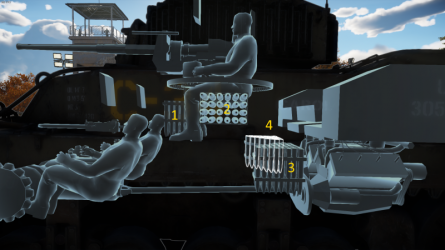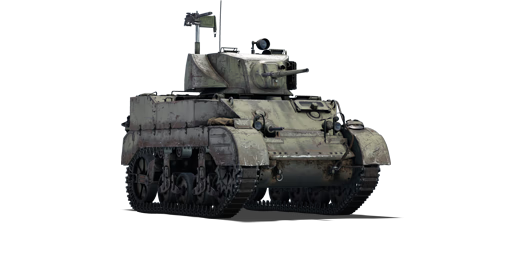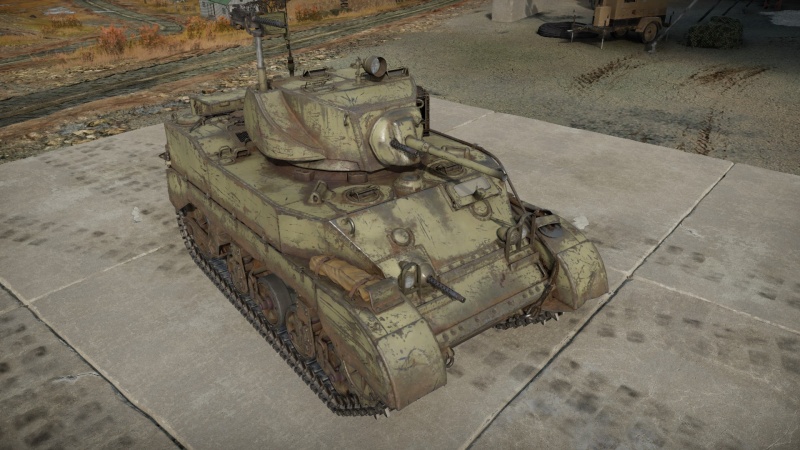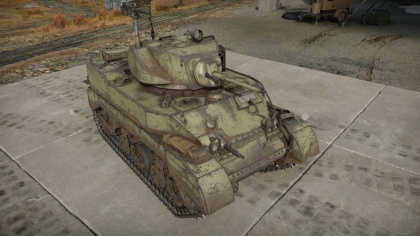M5A1 (China)
Contents
| This page is about the light tank M5A1 (China). For other uses, see M5 (Disambiguation). For other vehicles of the family, see M5 Stuart (Family). |
Description
The ␗Light Tank M5A1 Stuart is a rank II Chinese light tank
with a battle rating of 2.3 (AB) and 2.7 (RB/SB). It was introduced in Update 1.91 "Night Vision".
General info
Survivability and armour
The frontal armour on the ␗M5A1 Stuart is pretty tough for a light tank, with sloped 28 mm on the front of the hull, and a large, 50 mm thick gun mantlet covering up most of its frontal turret. When angled correctly, hull down or at a distance it can bounce off quite a few shots. However it can still be easily penetrated by average guns on its BR. From the front the 4 crews are sitting pretty close together, thus making it highly possible to get one-shot by shells with explosives like the Soviet 45 mm AP or the German short 75 mm APHE. The transmission and the engine are all quite small and low, and the ammoracks are also small, reducing the chance of being immobile or ammoracked. There is also an empty area under the turret crews and in front of the driving compartment, which will absorb those shells with weak damage.
Armour type:
- Rolled homogeneous armour
- Cast homogeneous armour (Gun mantlet, Lower glacis)
| Armour | Front (Slope angle) | Sides | Rear | Roof |
|---|---|---|---|---|
| Hull | 28.5 mm (49°) Front glacis 63.5 mm (33-37°) Lower glacis |
28.5 mm | 28.5 mm (46°) Top 25.4 mm (1°) Middle 25.4 mm (20°) Bottom |
12.7 mm |
| Turret | 44.4 mm (11-13°) Turret front 50.8 mm (2-43°) Gun mantlet |
31.75 mm (1°) | 31.75 mm (1°) | 12.7 mm |
Notes:
- Suspension wheels, bogies, and tracks are 15 mm thick.
- Tracks are placed on the turret side and rear that can provide about 10 mm of extra armour.
- An extra 12.7 mm RHA metal plate is present on the right side of the turret near the pintle 7.62 mm machine gun.
- A 5 mm Structural steel box is present, mounted on the vehicle rear.
Mobility
| Game Mode | Max Speed (km/h) | Weight (tons) | Engine power (horsepower) | Power-to-weight ratio (hp/ton) | |||
|---|---|---|---|---|---|---|---|
| Forward | Reverse | Stock | Upgraded | Stock | Upgraded | ||
| Arcade | 65 | 17 | 15.7 | 459 | 565 | 29.24 | 35.99 |
| Realistic | 58 | 15 | 262 | 296 | 16.69 | 18.85 | |
As it benefits from regenerative steering, turning on the spot with the M3A3 Stuart (China) is easier than for most tanks at the same BR. Regenerative steering consists in letting the unsolicited track rotate when the tank is turning instead of locking it. The hull is also short and wide enough, allowing it to turn agilely. However the reverse speed is average: it will not get you out of a dangerous situation quickly but isn't a handicap either. The ␗M5A1 Stuart reaches 18 km/h when fording and 16 km/h when driving uphill.
While its high speed is an advantage, it can turn into a disadvantage when manoeuvring at high speed: the ␗M5A1 Stuart, just like the previous M3A3, will start skidding uncontrollably if you take a sharp turn. Be aware of this before rushing towards the frontline: limit your maximum speed, know the terrain and anticipate the braking phases.
The acceleration is also so powerful that it causes you hull to rock back and forth during acceleration or braking phases. This effect is however nullified by the gun stabilizer when driving under 10 km/h.
Light and medium obstacles (fences, posts, bushes and small trees) are not a problem for the ␗M5A1 Stuart but large obstacles will reduce your mobility: avoid them.
Modifications and economy
Armaments
Main armament
While it lacks the post-penetration damage to disable most enemies in one shot, it can quickly finish them off with its fast reload. Knowledge of enemy vehicle layouts is essential with ammunition lacking post-penetration explosive damage. Make sure to target modules and crew positions to maximise the damage. Disabling the enemy gunner on your first shot will be critical to win engagements as you'll most likely need several shots to destroy an enemy vehicle.
| 37 mm M6 | Turret rotation speed (°/s) | Reloading rate (seconds) | |||||||||||
|---|---|---|---|---|---|---|---|---|---|---|---|---|---|
| Mode | Capacity | Vertical | Horizontal | Stabilizer | Stock | Upgraded | Full | Expert | Aced | Stock | Full | Expert | Aced |
| Arcade | 147 | -12°/+20° | ±180° | Vertical | 22.85 | 31.62 | 38.40 | 42.47 | 45.18 | 3.77 | 3.33 | 3.07 | 2.90 |
| Realistic | 14.28 | 16.80 | 20.40 | 22.56 | 24.00 | ||||||||
Ammunition
| Penetration statistics | |||||||
|---|---|---|---|---|---|---|---|
| Ammunition | Type of warhead |
Penetration @ 0° Angle of Attack (mm) | |||||
| 10 m | 100 m | 500 m | 1,000 m | 1,500 m | 2,000 m | ||
| M74B1 | AP | 79 | 76 | 65 | 54 | 45 | 37 |
| M63 shell | HE | 3 | 3 | 3 | 3 | 3 | 3 |
| M51B1/B2 | APCBC | 87 | 84 | 73 | 60 | 50 | 41 |
| Shell details | |||||||||
|---|---|---|---|---|---|---|---|---|---|
| Ammunition | Type of warhead |
Velocity (m/s) |
Projectile Mass (kg) |
Fuse delay (m) |
Fuse sensitivity (mm) |
Explosive Mass (TNT equivalent) (g) |
Ricochet | ||
| 0% | 50% | 100% | |||||||
| M74B1 | AP | 883 | 0.87 | N/A | N/A | N/A | 47° | 60° | 65° |
| M63 shell | HE | 807 | 0.73 | 0.1 | 0.5 | 38 | 79° | 80° | 81° |
| M51B1/B2 | APCBC | 883 | 0.87 | N/A | N/A | N/A | 48° | 63° | 71° |
Ammo racks

| Full ammo |
1st rack empty |
2nd rack empty |
3rd rack empty |
4th rack empty |
Visual discrepancy |
|---|---|---|---|---|---|
| 147 | 111 (+36) | 74 (+73) | 37 (+110) | 1 (+146) | No |
Machine guns
| 7.62 mm M1919A4 | ||||
|---|---|---|---|---|
| Mount | Capacity (Belt) | Fire rate | Vertical | Horizontal |
| Pintle | 3,000 (250) | 500 | -10°/+70° | ±60° |
| Coaxial | 3,000 (250) | 500 | N/A | N/A |
Usage in battles
The M5A1 Stuart preserves the Rank I style of fighting. With very good mobility and fast reload, the light tank can speed to an optimal position on the enemy's side and riddle them with the 37 mm cannon. It is recommended to attack from the flanks as the weak armour on the Stuart makes it vulnerable to the newer enemy guns that can penetrate the armour with ease.
With the fast reloading 37 mm cannon, the M5A1 Stuart can deliver some good-hitting rounds if shooting at the flank at the enemies. A frontal engagement is possible but detrimental as Stuart's thin armour makes any incoming shot lethal. If coming up to heavily armoured vehicles like the KV-1, load the M74B1 AP round for maximum penetration. In the case the M5A1 does come across a KV-1, the recommended course of action to take it out is to get in a point-blank range and fire at the turret ring or engine rear, otherwise, there is no way for the Stuart's 37 mm to penetrate the armour.
With its weak overall armour, most enemies are able to penetrate the M5A1 Stuart. A specific concern should be to vehicles with a high rate of fire weaponry such as the SPAA, which might be able to penetrate through weak points around the Stuart with enough effort. Enemies with strong shells like the Panzer IV with it's short 75 mm and its HEAT rounds could also destroy the Stuart with ease.
Enemies worth noting:
Specific enemy vehicles that bear mentioning are firstly any Germans with the 20 mm KwK/FlaK38 cannon, this gun might be small but can have up to 64 mm of pen, which is enough to go through the ␗M5A1 Stuart almost anywhere. These guns can also fire 10 rounds at 280 rounds/min before having to reload the clip, meaning that they will very easily take out your crew before you have a chance to respond. To counter, the best chance you have is to angle your frontal armour which can make it difficult for the PzGr 40 rounds to penetrate. The Russian T-50 and T-126 are vehicles you will also see commonly, these have fairly thick and angled frontal armour that will prevent you from easily getting through. These tanks can also carry an APHEBC round that will destroy you in one shot with little difficulty, to counter you should use your speed to attempt to get a side shot into either the turret or engine. If the T-50 cannot move you can outrun its turret and finish it without much difficulty.
It is likely that the M5 will encounter some rough heavies, like the Matilda III and the B1 bis. The best tactic against these types of targets is to use the ␗M5A1 Stuart's fast speed, get within 200 m from them and attack, with shooting at point-blank range being the most effective way. Before conducting an attack, check the ␗M5A1 Stuart's and the enemy's surroundings to make sure no one will ambush the ␗M5A1 Stuart. While charging, use the ␗M5A1 Stuart's quick turns to suddenly change direction to avoid being shot if they are aiming and firing at the ␗M5A1 Stuart. Once the tank is at the ideal distance, manoeuvre so that the gun is vertical to their armour. Do not shoot if the enemy is angling! The small calibre 37 mm gun is very likely to bounce off or not penetrate against sloped armour.
For the Matilda III, shoot at the middle of the near-vertical frontal plate to knock out the driver first, since the 37 mm shell is not enough to knock out the gunner after penetrating. Once it is immobile, go to its side and finish it by shooting its hull sides. Or, shoot the right side of the gun mantlet to disable its gunner. For best chance of penetration, do not shoot its turret side.
For the B1, either aim for the near-vertical frontal armour plate at the right side of the hull, or the turret ring to incapacitate the commander/gunner, or simply move to its side and knock out the crews one by one by hitting its flat side armour.
Modules
| Tier | Mobility | Protection | Firepower | ||
|---|---|---|---|---|---|
| I | Tracks | Parts | Horizontal Drive | M51B1/B2 | |
| II | Suspension | Brake System | FPE | Adjustment of Fire | Airstrike |
| III | Filters | Crew Replenishment | Elevation Mechanism | ||
| IV | Transmission | Engine | Artillery Support | Improved optics | |
Pros and cons
Pros:
- High top speed, good acceleration especially on flat terrain
- Better handling than it's predecessors, quick turning speeds
- Sloped armour can deflect some shots from small calibre projectiles
- Good rate of fire
- Gun can penetrate most tanks of this rank
- Can quickly rotate in place while not in forward or reverse motion
- Roof mounted 30.cal is useful for engaging aircraft
Cons:
- Crew of four leaving one spare, vehicle efficiency decreases after the spare crew is used up
- Exposed engine and fuel tank, prone to fires
- As with the American 37 mm cannons, AP rounds does not contain HE filler
- AP Shots often fail to fragment when penetrating other vehicles
- Relatively tall for a light tank, a challenge to find adequate defensive positions
History
Development
The American light tank design prior to World War II, the M2 light tank, was seen as obsolete after observing Germany's Panzer forces tear through Europe. The design was to be upgraded with more armour, a better suspension, and a new gun recoil system. The revised version was designated the Light Tank M3, and given the name "General Stuart" by the British, which becomes part of the name. At its basis, the light tank had a 37 mm cannon with a similar layout as the M2 light tank, with the radial engine at the rear and the transmission on the front, though the radial engine was in high demand so the Guiberson diesel T-1210 were fitted in some models to substitute the engine. The design used the VVSS bogie system seen on previous American tank designs. The tank had a crew of four: driver, assistant driver, gunner, and commander, who doubled as the loader.
The first variant of the M3 Stuart light tank was very similar to the M2 light tanks. It had five machine gun armaments scattered around like the M2 but featured better armour and a better cannon with the 37 mm M6 cannon. The design did not have a turret basket for the crew and it was constructed out of rivets, which increased the chance of spalling in the tank. Nevertheless, the first variant M3 saw about 5,811 units produced. The second variant, the Light Tank M3A1 Stuart, featured a new turret with no cupola on it, plus an added gun stabilizer. The machine guns on the hull sides were removed, so now the total machine guns were reduced from five to three. The design also featured a welded armour design to remove the weakness of riveted armour. 4,621 of this variant was produced from May 1942 to February 1943. The most used variant, the Light Tank M5A1 Stuart, had a completely redesigned hull and turret, with the hull most notably having a full sloping frontal armour than the previous designs. This variant had about 6,810 units produced. All in all, the Stuart light tank design and its variants were produced in massive quantities from March 1941 to October 1943 with a total of 25,000 units produced.
Combat usage
The British were the first to use the M3 Stuart in Africa in 1941, using it in Operation Crusader. However, the result ended with heavy losses, due to the better training the German Afrika Korps had compared to the British tank doctrine. The encounter also pointed out many flaws in the Stuart, mainly the cramped interior and limited operational range, but was praised for its high mobility and reliability when compared to the British contemporary designs. In 1942, the Stuarts were generally kept as recon units rather than combat units, and some were even modified to improve speed and range by removing the turret, and others were converted to armoured personnel carriers and command vehicles. Though the British used it extensively, it was still in small proportion compared to American usage. The Soviet Union was also another user of the Stuart tanks but found it unfavourable due to their own logistics, plus it was not made to withstand the Russian Rasputitsa or even the winter. The Soviet eventually turned down any more offers for the Stuart by 1943. The Stuarts also supported the British and Chinese forces in Asia against the Japanese Army, and also France and Yugoslavia in Europe against the German Wehrmacht.
The Americans used it widely in both operational theatres. In the Pacific, the Stuarts were the first tanks America used in a tank vs. tank operation against the Imperial Japanese Army, where five M3s fought Type 95 Ha-Gos in the Phillippines. Though the Stuarts were newer than the Japanese tank designs by about five years, they were seen as equal in performance and firepower, but the Stuart benefited by the support of the American industry arm. The Stuarts served in the Pacific slightly better than its heavier counterparts such as the M4 Shermans due to its lighter weight and manoeuvrability in the poor jungle terrain, but the Stuarts in the Pacific were gradually replaced by M4 Shermans. In Europe, the Stuarts formed a large part of the American tank battalions, though following the British path by sidelining the Stuarts from combat duties after heavy losses and to serve alongside Shermans as scouting units. A typical tank battalion for the US Army consisted of three companies of Shermans and one of the Stuarts. The Stuarts, other than scouting, were also used in cavalry roles and infantry support since their cannon are unable to compete with the German tank designs. Despite their dwindling capabilities in battle, the Stuart was kept in service up until the end of the war due to the large production numbers.
After World War II, the Stuarts were given out as cheap surplus, countries such as China, India, and Pakistan picked up a few and used them in their conflicts. Portuguese also picked up a few Stuarts for the war in Angola, and the South African Corps continued using the Stuarts until 1955, where some were still kept in service until 1968 due to available parts. Today, Paraguay is still a user of the Stuart light tanks, though as the only tracked armour used in the country.
The Stuart light tank design was also quite versatile that it was made into different variants for different roles on the battlefield. It served as an infantry support vehicle as to the 75mm GMC M8 and experiments were also taken to see if it could be adapted to an anti-aircraft gun and a flamethrower as well. However, the Stuarts were becoming an ageing design with inferior armour, cramped interior layout, and a small 37 mm gun, so a program to replace the light tank began in 1943 and became the M24 Chaffee, which would eventually replace the Stuarts mostly after World War II.
Media
- Skins
- Videos
See also
Links to the articles on the War Thunder Wiki that you think will be useful for the reader, for example:
- reference to the series of the vehicles;
- links to approximate analogues of other nations and research trees.
External links
Paste links to sources and external resources, such as:
- topic on the official game forum;
- encyclopedia page on the tank;
- other literature.
| China light tanks | |
|---|---|
| Type 63 | Object 211 · Type 63 · ZTS63 |
| Type 62 | Type 62 |
| WZ551 | ZSL92 · PTL02 · WMA301 |
| ZBL08 | ZLT11 |
| Type 86 | ZBD86 |
| WZ502 | ZBD04A |
| ROC | M41D · M64 |
| Type 59 | QN506 |
| USA | ␗M8 LAC · ␗M3A3 Stuart · ␗M3A3 (1st PTG) · ␗M5A1 · ␗M24 · ␗M18 GMC · ␗M41A3 |
| USSR | ␗T-26 · T-26 No.531 · ␗PT-76 |






